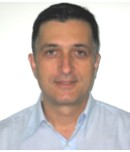

Plenary Lecture
Large RES Penetration in Autonomous Electric Grids – The Role of Pumped Hydro Storage

Associate Professor John S. Anagnostopoulos
School of Mechanical Engineering
National Technical University of Athens
GREECE
E-mail: anagno@fluid.mech.ntua.gr
Abstract: In recent years, the energy policy of EU and of many other countries worldwide has paid major attention to renewable sources, focusing on a drastic increase and possible maximization of their share in power production. Wind and solar energy are the most significant and mature renewable technologies, which are already incorporated at a certain degree in many electricity systems. However the stochastic, intermittent and fluctuating nature of the power production of these sources obstructs their unlimited penetration in the existing grids. A maximum value of 40 to 50 percent is considered feasible for large interconnected systems, whereas in isolated autonomous grids the feasible penetration is quite smaller, of the order of 30%. Consequently, the continuous installation of RES units into an electricity power system will eventually lead to saturation conditions and inability for further exploitation of RES potential. Such conditions are encountered today only in some autonomous Island systems, but in the next years it is expected to confront also in larger mainland electricity systems, due to the rapid development of RES units worldwide.
Solutions to overcome this problem has been proposed for small and medium autonomous electricity grids, and they may be applicable at some extend also to larger interconnected systems. The principal concept is the combination of RES production with energy storage facilities, in order to be able to store the surplus RES production which cannot be absorbed (usually during the night-time hours), and use it again to produce electricity in high demand periods. Pumped hydro storage is at present the most mature and suitable technology for energy storage in medium to large power quantities and capacity sizes, and consequently, is the option considered in some pilot plants that have been designed and are being constructed today, like in the Canary Islands and in the Greek island Ikaria.
This RES hydro storage procedure is however quite different than the conventional pumped storage practice, and for this reason needs special investigation. It was found that the exploitation of RES and hydroturbine production becomes more flexible and efficient if the production system is treated as a single, combined unit, forming a hybrid RES-hydro power plant. This concept introduces two major issues: The optimum design and sizing, and the optimum operation strategy of this hybrid plant. The main objective is usually the maximization of the economic results of the investment, whereas, on the other hand, minimization of the fossil fuels usage and maximization of RES penetration in the electricity system constitute important parallel targets. The major controlling parameter and a challenging issue is the proper electricity pricing policy, which will be able to support the economic viability of such investments and at the same time to retain or reduce the electricity production cost in the entire system. Moreover, the installation of such hybrid plants should not affect the interests of other independent RES producers already operating in the system.
The first part of this lecture presents the basic energy and technology aspects, and the limitations of large RES integration and operation in autonomous electricity systems, with some examples of ongoing pilot projects. The second part focuses on the case of Greece and the recently established legislation and regulations that control the design and operation of hybrid power plants in the non-interconnected systems of the Islands. It analyses the new concepts of guaranteed power and guaranteed energy of these units, and lists some technical and operation issues that remain open.
Brief Biography of the Speaker: John S. Anagnostopoulos graduated in Mechanical Engineering from the National Technical University of Athens, Greece, and received his Ph.D. in Computational Fluid Mechanics from the same University in 1991. He worked for several years as research scientist in the NTUA and as R&T consultant in the private sector, where he has been involved in feasibility studies for various industrial innovations. He has participated in many research projects and developed several computer codes for the simulation of various fluid mechanisms in industrial applications (pulverized coal combustion, fouling, coal grinding, liquid fuel spray aerodynamics, electrostatic precipitation, atmospheric flows and pollutant dispersion, pollutant formation and photochemical kinetics, pulsating flows, steel continuous casting, metal thermal spraying, mechanical erosion wear, flow in centrifugal pumps and impulse hydro turbines), as well as for modelling of hydroelectric and hybrid energy systems. He is Associate Professor in Hydraulic Turbomachines at the School of Mechanical Engineering, NTUA, and his current research activities include flow simulation and hydrodynamic design optimization in hydraulic turbomachinery with Eulerian and Lagrangian techniques, and optimal design and operation strategies of autonomous and integrated power production systems combining RES and pumped hydro storage.